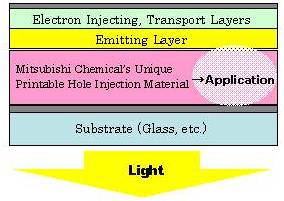Mitsubishi Chemical has announced plans to enter the OLED lighting business using OLED panels supplied by Pioneer. They aim to begin full-scale mass production with a launch of illumination appliances in 2011. Target sales for the OLED lighting business are predicted at over US$0.5 billion for 2015, and over US$1 billion for 2020. The companies are also discussing the possibility of researching and developing printable OLED lighting with a view of commercialisation in the future.
In order to strengthen the strategic partnership between the two companies, Pioneer will issue Mitsubishi Chemical about 600 million Japanese yen in new stock through third-party allotment.
Both companies are currently performing joint research on OLED lighting panels that use printable hole injecting material (HIM) and new emitting materials.
OLED lighting
OLED lighting does not create a spot of light or strip of light like electric bulbs and fluorescent lights, the whole body emits light in a way that is easy on the eyes. Brightness and color can be freely controlled (dimness/tone), it can be made transparent (can see through to the other side like a glass window), and it can be made flexible (light surface can be flat or curved, shapes can be freely formed). Also, the fact that it does not use mercury and uses low amounts of energy makes it an environmental-friendly next-generation lighting that is receiving high expectations.
Mass production of OLED lighting panels
Currently, OLED lighting panels are commonly created through a vapor deposition process, which makes it difficult to mass-produce no-defects, large, uniform surfaces. However, Mitsubishi Chemical's printable materials realize the mass production of lighting area, about 14cm square - believed to be the world's largest class, with Pioneer's commercial lines.
The company plans to display the world's first dimmable/tone adjustable prototype this year in Frankfurt, Germany next month.
Both companies are continuing their joint research on OLED lighting panels for both printable HIM and new printable emitting materials. These new printable materials enable an emitting layer to be applied via a low-cost application process -an illumination life time of 10,000 hours has been achieved in the laboratory.
OLED lighting panel that utilizes printable hole injecting material

For more attend Printed Electronics Europe 2010.
Reference and images: Mitsubishi






